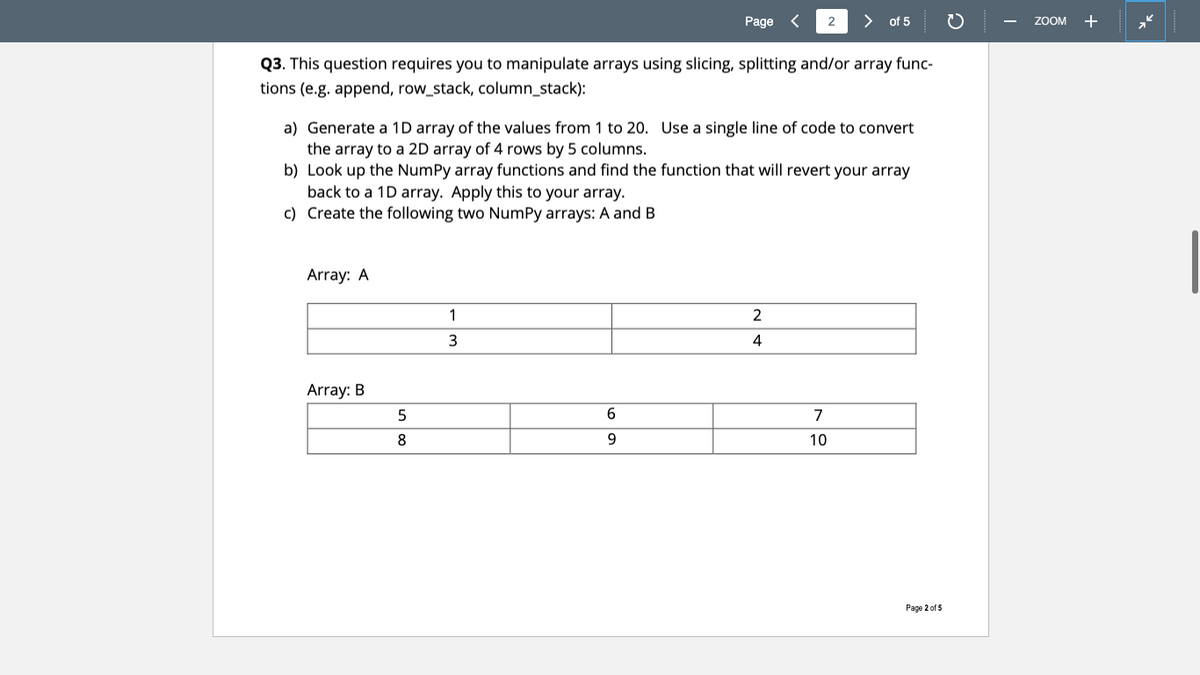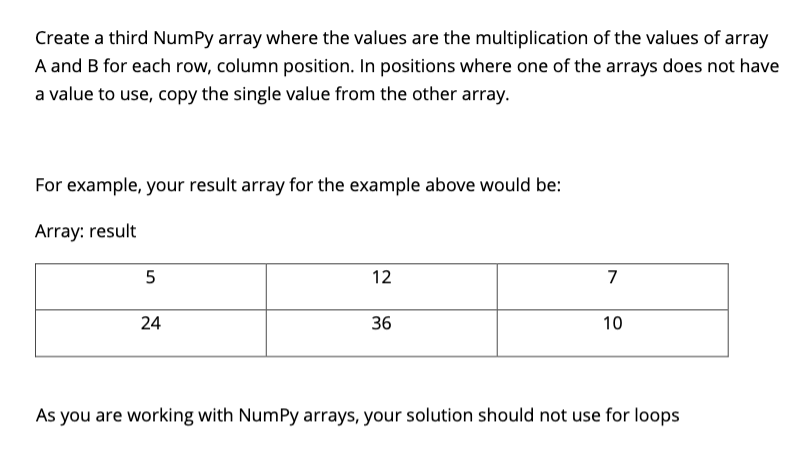Q3. This question requires you to manipulate arrays using slicing, splitting and/or array func- tions (e.g. append, row_stack, column_stack): a) Generate a 1D array of the values from 1 to 20. Use a single line of code to convert the array to a 2D array of 4 rows by 5 columns. b) Look up the NumPy array functions and find the function that will revert your array back to a 1D array. Apply this to your array. c) Create the following two NumPy arrays: A and B Array: A 1 2 4 Array: B 5 7 8 10
Q3. This question requires you to manipulate arrays using slicing, splitting and/or array func- tions (e.g. append, row_stack, column_stack): a) Generate a 1D array of the values from 1 to 20. Use a single line of code to convert the array to a 2D array of 4 rows by 5 columns. b) Look up the NumPy array functions and find the function that will revert your array back to a 1D array. Apply this to your array. c) Create the following two NumPy arrays: A and B Array: A 1 2 4 Array: B 5 7 8 10
Database System Concepts
7th Edition
ISBN:9780078022159
Author:Abraham Silberschatz Professor, Henry F. Korth, S. Sudarshan
Publisher:Abraham Silberschatz Professor, Henry F. Korth, S. Sudarshan
Chapter1: Introduction
Section: Chapter Questions
Problem 1PE
Related questions
Question
Language - Python

Transcribed Image Text:Page
>
of 5
ZOOM +
Q3. This question requires you to manipulate arrays using slicing, splitting and/or array func-
tions (e.g. append, row_stack, column_stack):
a) Generate a 1D array of the values from 1 to 20. Use a single line of code to convert
the array to a 2D array of 4 rows by 5 columns.
b) Look up the NumPy array functions and find the function that will revert your array
back to a 1D array. Apply this to your array.
c) Create the following two NumPy arrays: A and B
Array: A
4
Array: B
6.
7
8
9.
10
Page 2 of 5

Transcribed Image Text:Create a third NumPy array where the values are the multiplication of the values of array
A and B for each row, column position. In positions where one of the arrays does not have
a value to use, copy the single value from the other array.
For example, your result array for the example above would be:
Array: result
12
7
24
36
10
As you are working with NumPy arrays, your solution should not use for loops
Expert Solution
This question has been solved!
Explore an expertly crafted, step-by-step solution for a thorough understanding of key concepts.
Step by step
Solved in 3 steps with 6 images

Knowledge Booster
Learn more about
Need a deep-dive on the concept behind this application? Look no further. Learn more about this topic, computer-science and related others by exploring similar questions and additional content below.Recommended textbooks for you

Database System Concepts
Computer Science
ISBN:
9780078022159
Author:
Abraham Silberschatz Professor, Henry F. Korth, S. Sudarshan
Publisher:
McGraw-Hill Education

Starting Out with Python (4th Edition)
Computer Science
ISBN:
9780134444321
Author:
Tony Gaddis
Publisher:
PEARSON

Digital Fundamentals (11th Edition)
Computer Science
ISBN:
9780132737968
Author:
Thomas L. Floyd
Publisher:
PEARSON

Database System Concepts
Computer Science
ISBN:
9780078022159
Author:
Abraham Silberschatz Professor, Henry F. Korth, S. Sudarshan
Publisher:
McGraw-Hill Education

Starting Out with Python (4th Edition)
Computer Science
ISBN:
9780134444321
Author:
Tony Gaddis
Publisher:
PEARSON

Digital Fundamentals (11th Edition)
Computer Science
ISBN:
9780132737968
Author:
Thomas L. Floyd
Publisher:
PEARSON

C How to Program (8th Edition)
Computer Science
ISBN:
9780133976892
Author:
Paul J. Deitel, Harvey Deitel
Publisher:
PEARSON

Database Systems: Design, Implementation, & Manag…
Computer Science
ISBN:
9781337627900
Author:
Carlos Coronel, Steven Morris
Publisher:
Cengage Learning

Programmable Logic Controllers
Computer Science
ISBN:
9780073373843
Author:
Frank D. Petruzella
Publisher:
McGraw-Hill Education